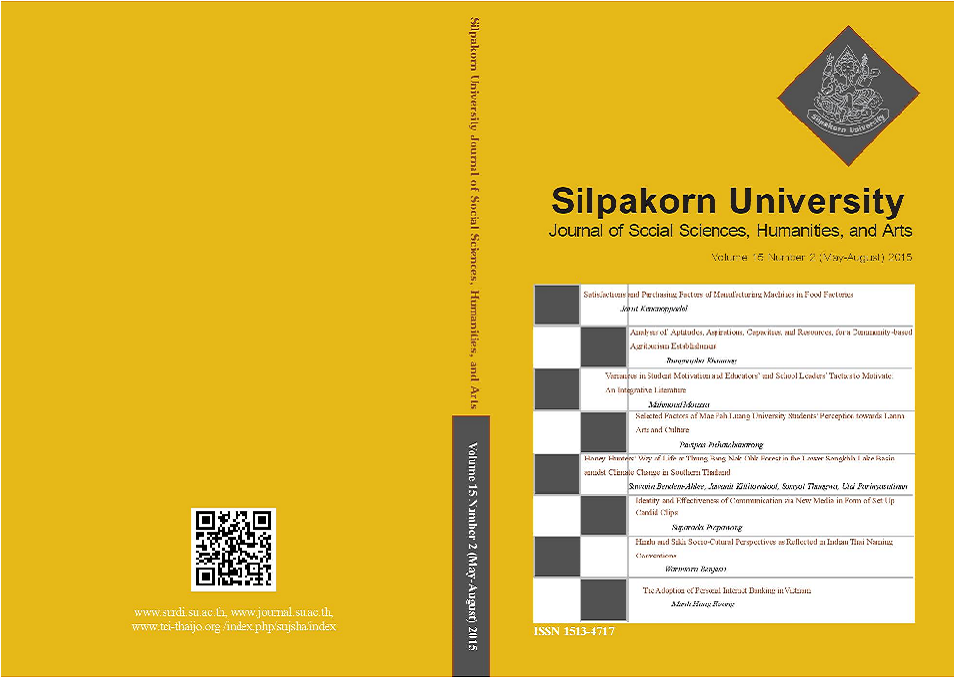Honey Hunters’ Way of Life at Thung Bang Nok Ohk Forest in the Lower Songkhla Lake Basin amidst Climate Change in Southern Thailand
Main Article Content
Abstract
In the Southern part of Thailand, especially in the LowerSongkhla Lake Basin, climate change has affected the way of life ofthe surrounding communities where people’s lives depend on naturalresources. In Songkhla Province, Thung Bang Nok Ohk is the largestmelaleuca forest to which Apis dorsata F. migrate in the beginning of therainy season when melaleuca flowers begin to bloom. Wild honey has beenan income source for people in the community for more than a century.The local wisdom used by villagers to hunt for wild honey is to makenests called “Bang Kad”. However, with changes in the environment likeforest encroachments, forest fires and climate change, forests have beenaffected and villagers can perceive the changes, especially their occupationin harvesting wild honey. During the last decade, villagers know that theamounts of honey they can collect have been less than before. This articleaims to reveal that villagers can perceive the climate change in the seasonsof the year, the amount and intensity of rainfall, and the change of windvelocity. These factors affect the wild honey production and the incomethey make from selling it which has obviously declined. The number of “Bang Kad” they make to nest honeybees and that of beehives made byhoneybees are in inverse relation, that is tosay the number of “Bang Kad”increases while that of the beehives decreases. Because of their perceptionof the problems, wild honey hunters have gathered into a group ofcommunity enterprise that conserves giant honeybees. This is another wayof preserving the forest for sustainable utilization by the community.
Downloads
Article Details
All rights reserved. Apart from citations for the purposes of research, private study, or criticism and review,no part of this publication may be reproduced, stored or transmitted in any other form without prior written permission by the publisher.
References
Climatological Center -Meteorological Department. (2009) Prediction of climate change in the future. [Online URL: https://www.tmd.go.th/programs/uploads/intranet/DOCS/ncct-0008.pdf] accessed on May 6, 2015.
Conte, Y. L. and Navajas, M. (2008) Climate Change: Impact on Honey Bee Populations and Diseases. Revve scientifique et technique (International Office of Epizootics) 27(2): 499-510.
Grigoras, O. (2012) Beehive-Like Eco Hotel Designed in Ukraine. [Online URL: https://news.softpedia.com/news/Beehive-Like-Eco-Hotel-Designed-in-Ukraine-247570.html] accessed on August 17, 2013.
Hydro and Agro Informatics Institute (Public Organization). (2013) Climate of Songkhla Lake Basin. [Online URL: https://www.haii.or.th/wiki/index.php/climateofSongkhlaLakeBasin/] accessed on July 20, 2013.
Khuan So Sub-district Administrative Organization. (2014) Basic Information. In The Development plan documents of the three-year plan 2015-2017 of Khuan So Sub-district Administrative Organization, p. 17. Songkhla: Khuan So Sub-district Administrative Organization.
Kizito, G. (2010) Using Local Style and Top-Bar Hives in Uganda. Bee for Development Journal. [Online URL: https://www.beesfordevelopment.org/uploads/Issue95053.pdf] accessed on August 17, 2013.
Kumar, M. S, Ranjit, S and Alagumuthu, G. (2012) Traditional Beekeeping of Stingless Bee (Trigona sp) by Kani Tribes of Western Ghats, Tamil Nadu, India. Indian Journal of Traditional Knowledge 11(2): 342-345. [Online URL: https:// nopr.Niscair.res.in/bitstream/123456789/13867/1/IJTK%2011(2)%20342-345.pdf] accessed on August 8, 2013.
Park, S. M. and Yeo-Chang, Y. (2012) Traditional Knowledge of Korean Native Beekeeping and Sustainable Forest Management. Forest Policy and Economics 15: 37-45. [Online URL: https://www.sciencedirect.com/science/article/pii/S1389934111001948] accessed on August 8, 2014.
Parvu, M., Andronie, I. C, Simion, V. E. and Amfim, A. (2013) Studies Concerning the Impact of Climate Changes on Honeybees Behaviour. Animal Science and Biotechnologies 46(2): 282-284. [Online URL: https://spasb.ro/index.php/spasb/article/download/145/289] accessed on August 8, 2014.
Pokhrel, S. (2010) Climeto-Cylic Immigrations with Declining Population of Wild Honeybee, Apis Dorsata F. in Chitwan Valley, Nepal. Agriculture and Environmental 11: 51-58. [Online URL: https://www.nepjol.info/index.php/AEJ/article/download/3652/3133] accessed on August 8, 2014.
Rader, R., Reilly, J., Bartomeus, I. and Winfree, R. (2013) Native Bees Buffer the Negative Impact of Climate Warming on Honey Bee Pllination of Watermelon Crops. Global Change Biology 19: 3103-3110. [Online URL: https://onlinelibrary.wiley.com/doi/10.1111/gcb.12264/pdf] accessed on August 8, 2014.
Rattanawannee, A., Chanchao, C. and Wongsiri, S. (2012) Geometric Morphometric Analysis of Giant Honeybee (Apis dorsata Fabricius, 1793) Populations in Thailand. Asia-Pacific Entomology, 15: 611–618. [URL: https://www.sciencedirect.com/science/article/pii/S122 6861512000969] accessed on August 4, 2014.
Reddy , R. P. V., Verghese, A. and Rajan ,V. V. (2012) Potential Impact of Climate Change on Honey Bees (Apis spp.) and Their Pollination Services. Pest Management in Horticultural Ecosystems 18 (2): 121-127. [Online URL: https://www.aapmhe.in/index.php/pmhe/article/download/3/2] accessed on August 7, 2014.
Suttiwipakorn, W., Editor. (2008) Our Lake. The master plan for the development Songkhla Lake Basin, Songkhla Rajabhat University and Prince of Songkla University. Songkhla: OS Printing House.
Suwannapong, G, Benbow, M., Eric and Nieh, J. C. (2011) Biology of Thai Honeybees: Natural History and Threats. [Online URL: https://labs.biology.ucsd.edu/nieh/ papers/ThaiHoneybeesPageProofs.pdf] accessed on August 3, 2013.
Thai Marine Meteorological Center. (2006) Climage Songkhla. [Online URL: https://www.marine.tmd.go.th/thai/tus_type/songkhla.html] accessed on May 6, 2015.
Thai Meteorological Department. (2009) Predictions of future climate change. [Online URL: https://www.tmd.go.th/programs/uploads/intranet/DOCS/ncct-0008.pdf] accessed on February 25, 2014.
Thai Meteorological Department. (2009-2012) Climate of Thailand from 2009-2012. [Online URL: https://www.tmd.go. th/climate/climate.php?FileID=5] accessed on August 8, 2013.
Thai Meteorological Department. (2013) Tropical Cyclone Moving to Thailand in a Month Period in 62 Years (1949-2012). [Online URL: https://www.tmd.go.th/programs%5Cuploads%5Ccyclones%5CTCtrack62y.pdf] accessed on November 16, 2013.
Thai Meteorological Department. (2014) Meteorological knowledge (statistics of tropical cyclone moving through Thailand. [Online URL:https://www.tmd.go.th/info/info.php?FileID=27] accessed on May 6, 2015.
Southern Meteorological Center (East Coast). (2014) Meteorological data in Songkhla. [Online URL: https://www.songkhla.tmd.go.th/songkhla.html] accessed on May 6, 2015.
Thailand Research Fund. (2012) TRF stage floods to global warming. TRF Policy Bulletin 2(10): 3-8.
Thapa, R. B. (1998) Cology Migration of the Giant Honey Bee, Apisdorsata Fabr. Doctoral Thesis in Entomology, Graduate School, Chulalongkorn University, Bangkok, Thailand.
Walker, P. and Crane, E. (2004) Stone Structure Used in France for Protecting Beehives. Journal of Culture Heritage 5: 245-255. [Online URL: https://www.sciencedirect.com/ science/article /pii/S1296207404000548] accessed on August 4, 2014.


